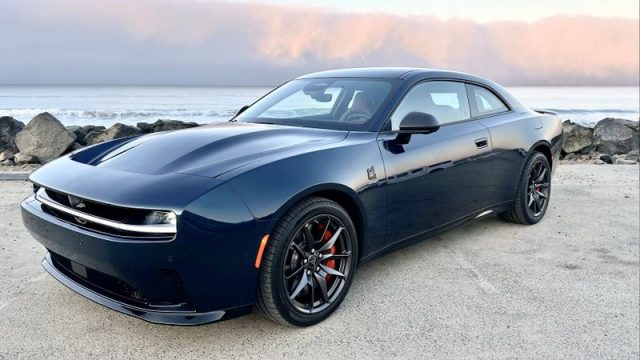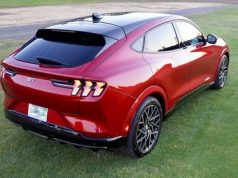Famed Muscle Car Goes Quietly. Sort of.
A question for muscle car fans. What car would you rather own?
Fast
Faster
Seems the latter would be the obvious choice for anyone wanting to win a 0-60 mph race and a few bar bets along the way. So what’s the deal with the muscle car crowd opting to go slower? Is it because for many the past is a more comfortable place than the future?
Here is how it shakes out at Dodge these days.
Fast: The gasoline-powered Dodge Charger Scat Pack with the 3.0-liter Hurricane Twin Turbo I-6 Sixpack H.O. engine: 0-60 mph in 3.9 seconds
Faster: The all-electric, twin-motor Dodge Charger Daytona Scat Pack Track Package: 0-60 mph in 3.3 seconds
If the deal-breaker is the word ‘electric,’ then you will never be convinced the Dodge Charger Daytona Scat Pack Track Package is worthy of your attention, even though it is the quickest Dodge Charger to ever come off the assembly line.
Dodge and Muscle Cars
Dodge has a long and glorious muscle car history going back to the late 1960s when dropping a fire-breathing gasoline-powered engine into a sedate family car became the rage. Dodge had such beasts; the Charger was one of the most successful of the breed. Don’t forget Steve McQueen in the film Bullitt chasing and being chased by a 1968 Dodge Charger R/T. Spoiler alert: It didn’t end well for the Charger.
Developing an all-electric Charger was a bold move. It raised eyebrows (plus ire, confusion and a few “Hell, no!” comments) from the large community of American-made muscle car owners and fans.
Dodge knew this would happen, but also knew the loudest were people that had never ridden in an EV let alone driven one. They knew if they could get them to take a Charger Daytona for a test drive they would, even if begrudgingly, admit it was the real deal and respectfully carries on the tradition of an American designed and built muscle car.
The Only All-Electric Muscle Car
The Dodge Charger Daytona EV comes in two versions.
R/T
456 base horsepower (hp). 496 hp when deploying Power Shot
404 pound-feet of torque (lb.-ft.)
Twin motors: Front and rear
All-Wheel Drive (AWD) standard
0-60 mph: 4.7 seconds
1/4 mile: 12.6 seconds. Top Speed: 135 mph
All-Electric-Range (AER): 308
Scat Pack Track Package
630 base hp. 670 hp when deploying Power Shot
627 lb.-ft. of torque
Twin motors: Front and rear axles each have a 250 kW motor
AWD standard
0-60 mph: 3.3 seconds
1/4 mile: 12.6 seconds. Top Speed: 135 mph
AER: 241
Ed note: Dodge is reportedly juggling the Daytona EV lineup for 2026. Some models, such as the top-of-the-line performance model Banshee, have been cancelled according to some officially unconfirmed reports.
A Performance EV With Efficiency
Not an oxymoron.
Clean Fleet Report drove the all-electric 2025 Dodge Charger Daytona Scat Pack Track Package 224 miles through Southern California, averaging a very respectable 3.1 miles per kWh. Respectable because the temptation to drive less-than-than conservatively was only a simple push of the Power Shot button away. That adds an instant 40 hp, unleashing all 670 hp and 627 lb.-ft. of torque to all four wheels.
The Environmental Protection Agency (EPA) rates the AER at 241 miles. This is low for an EV, but considering the 6,000-pound weight and the massive performance numbers it is quite reasonable. We took the battery to near zero before recharging, so we know the EPA number is very conservative.
Charging
The primary way to charge the 100.5 kWh battery (93.9 kWh usable) is by plugging in and using the onboard 11.0 kW inverter. A Level 1 (120V) common household plug will be long and slow, so investing in a Level 2 (240V) home wall charger or using one at a public charge station makes more sense. It will take up to 6.8 hours. DC Fast charging is the way to go. At 175 kW, the Charger Daytona will go from 5-80% in 52.4 minutes, but on a 350 kW charger it speeds along at 24 minutes.
The North American Charging Standard (NACS) plug is standard with an adapter for Combined Charging System (CCS) chargers.
The second way to charge is through regenerative braking that converts kinetic energy into electric energy when applying the brakes or coasting, and stores it in the battery. The strength of the regeneration is adjusted with the steering wheel mounted paddles, making it easy to drive with your fingertips under most conditions.
Dodge offers new owners two charging plans. One if you plan on doing most of your charging at home and the other if you charge mostly while on the road.
The Free2Move Home Charging Package includes a 48-amp Level 2 home charging station that provides 11.6 kilowatts of power. The cost to install the home charging station by a professional electrician is not included.
The Free2Move Charge-To-Go Package delivers owners $600 of charging credits. Accessed through the Free2Move Charge app, it can be used at more than 94,000 public charging stations across the U.S. and Canada.
The Fun Stuff!
It is always exciting getting into a car designed for high performance because of the unknown factor of what to expect. To whet our anticipation, Dodge proudly said the Charger Daytona is the “World’s only all-wheel drive electric muscle car.” Clean Fleet Report has driven and reviewed pretty much all the electric cars and can attest we have driven some fast and quick ones. But, none were designed as a muscle car, which is where the comparison ends.
The Charger Daytona has several driver-controlled settings to up the track and road capabilities. Remember to only use these on a drag or road course track or a closed-course.
Launch Control that lets the driver set the torque for maximum acceleration from a stop
Track Mode optimizes the speed and handling performance on a road course
Race Prep is used to prepare the Charger Daytona for either track or road racing by adjusting the battery temperature for optimal performance
Drift/Donut Mode sets-up the car for drifting, including in snow. These include:Switches to rear-wheel drive, which is what makes drifting and donuts possibleOptimizes the power distribution to the rear wheelsEnhanced Control provides handling and stability
Performance Enhancements include adjusting the regenerative braking and traction control
The Drive eXperience Recorder let you keep an accurate accounting of your track time
Hey, What’s That Noise!
The Dodge Charger Daytona has the Fratzonic Chambered Exhaust system. Right off the bat, it is confusing as an EV doesn’t have any exhaust! Branding and marketing aside, the Fratzionic system mimics traditional engine sounds with a chambered box. The box and two large speakers are mounted under the rear fascia. The Charger Daytona had to look, feel, drive and sound like a traditional Dodge muscle car. So does it? Checkout this video and let us know what you think.
What you get are deep and resonant rumbles that are affected by how aggressively the accelerator is depressed and which drive mode (Track and Drag are the loudest) is selected. Vibrations transmit through the car, adding another element attempting to soothe the hardcore muscle car crowd that is used to gasoline engines producing these sounds naturally. Will they be satisfied with the same 126-decibels produced by the V8 Hellcat?
The engine sounds do not come with simulated gear shifts like on the performance-oriented Hyundai Ioniq 5 N. This keeps the Charger Daytona driver from being fully engaged, left to cruise along with the sound blasting from the speakers. We also found driving around town it became annoying, so we turned it off. It isn’t a gimmick, but a cool technology connecting the future with the past.
Aerodynamics and Grip
The first (aerodynamics) improves efficiency and creates downforce, and the second (grip) handles it. The Dodge engineers put an R-Wing on the far front of the hood. This design element helps with efficiency, but also provides downforce keeping the front wheels planted at high speeds. It’s useful when coming off the line using Launch Control and hitting the Power Shot button on the steering wheel, which delivers an incremental 40 horsepower for 10 seconds. There is a 30-second recharge before using the Power Shot again.
The R-Wing will earn its keep when taking corners at twice their posted speed limit or hitting the drag strip. Dodge says the R-Wing reduces front lift by 30% and drag up to 3%, which is important for maximizing top speed.
Grip and cornering are handled by the 305/35 Goodyear Eagle Sport Performance all-season tires, on 20-inch Luster wheels, and the multi-link front and independent rear suspensions with adaptive dampers. Dodge calls this a Widebody Competition Suspension. The heavy battery pack helps, located in the middle of the body structure, beneath the floor.
Driving fast is directly related to stopping fast. The Charger Daytona has Brembo ultra-high-performance brakes, painted in bright red, glaring out of the wheels. They stopped smoothly and did not fade or have longer pedal travel after repeated hard use.
Clean Fleet Report put the Charger Daytona through about as rigorous set of challenges we could legally do on public roads. Had we been on a closed course, our experience would have turned it up a notch or two. Dodge has packed the Charger Daytona Scat Pack with the Track Package containing all the bits and pieces to allow it to be driven on the edge. It’s conceivable you will do that if you take it to your local drag strip, but most likely you will do what we did and just have a blast pushing it to the legal limits.
100% American Muscle Car Design
The Charger Daytona is true to muscle car design heritage. However, Dodge has taken it a bit further. It is 17-feet long, 6 1/2-feet wide, has a 121-inch wheelbase and at its highest point, barely scrapes 59 inches. It has a 5.6-inch ground clearance and a downward rake. The sum of the design is energetic, confident, sleek, dynamic, good-looking and well-proportioned. The most interesting design element is the afore-mentioned R-Wing, sitting at the end of the hood where it creates that aerodynamic downforce so important to this muscle car with up to 670 hp.
The Charger Daytona has two doors, but Dodge is taking orders now for a four-door sedan version. There are eight exterior colors with six at an additional cost of $795, including ours in After Dark that featured a glass roof. All premium colors have the option of a black steel roof.
The nose looks great with bi-function LED reflector head lamps peering from the slim upper grille, which has the illuminated Dodge logo and an LED light strip. Everything is smooth on the body, ending at the wide tail. LED tail lights, with an illuminated Dodge logo, run the full width of the keyless hands-free power trunk lid. This is no average trunk as it opens like a hatchback. Very unique and handy for accessing the cargo area.
The Charger Daytona is sans badging save for the ‘Banshee’ badge on the front fenders that signifies this Charger is electrified. [Ed. note: The Banshee also signaled a coming super performance model that now may or may not have been cancelled. Stay tuned.]
Pop the hood and the frunk (front trunk) is a welcome and secure storage space.
Driver-Focused Interior
The back seats are large and accommodating for two adults. When the rear 60:40 split seat is down, the cargo space really comes into view. If you are headed to the track, it will easily handle an extra set of racing tires and wheels, and loading them is easy in this hatchback.
The screens and gauges angle towards the driver. The 16.0-inch driver-configurable instrument display has carbon fiber and is wrapped in suede. (The 1968 Dodge Charger had neither!) The 10.25-inch infotainment touchscreen is home to the Alpine 18-speaker sound system with UConnect. Included are AM/FM HD radio, wireless Apple CarPlay and Android Auto, SiriusXM, Amazon Alexa integration and TomTom navigation. The flat-bottom, heated, leather-covered steering wheel has controls for the radio, cruise control, drive modes and the Power Shot button.
The center screen also displays climate controls and is the media hub for Bluetooth, streaming audio, and vehicle settings and other controls. Additional features include wireless phone charging, a universal garage door opener and a head-up display. There is no Auto Hold button, but the Charger Daytona can come to a complete stop through regenerative braking by selecting the ‘Creep Off’ setting in the center screen.
Our Charger Daytona has the Scat Pack Stage 2 and Plus Group package ($8,195 options) that included ventilated front seats that were 12-way power adjustable with heat and 4-way power lumbar and memory. The rear outbound seats are also heated. The Carbon and Suede Package ($2,995) included leather and suede seats, suede headliner and door panels with carbon fiber inserts.
Pricing and Warranties
The 2025 Dodge Charger Daytona comes in two versions with several available options and packages. Including the $1,995 destination fee, these are the base prices.
Daytona R/T $61,590
Daytona Scat Pack $75,980
Clean Fleet Report drove the Dodge Charger Daytona Scat Pack Track Package. With $18,675 in options and packages, and the $1,995 destination fee, the MSRP was $86,460.
The 2025 Dodge Charger Daytona comes with these warranties.
High-Voltage Battery – Eight years/100,000 miles
Electric Powertrain – Eight years/100,000 miles
Basic – Three years/36,000 miles
Observations: 2025 Dodge Charger Daytona EV Scat Pack Track Package
Expectations Met?
The Dodge muscle car DNA runs so deep they branded ‘Brotherhood of Muscle’ for its iconic powerful models like the Viper, SRT, Hellcat and Demon. Going back a few decades it was the Super Bee, Barracuda, Dart and the OG Challenger and Charger. So what is our conclusion of the Charger Daytona EV, specifically does it continue the muscle car heritage for Dodge?
The performance was thrilling and the all-electric driving range respectable for such a powerful and heavy coupe. The design faithfully revisits the 1960-1970 muscle car era, but with all the modern electronics and tech.
So how does the Charger Daytona EV fit into all this? We found it to be a fun high-performance electric muscle car that deserves more respect from the “if it ain’t gasoline, it isn’t a car” crowd. True, there will be no greasy fingers tuning and modifying the Charge Daytona (although modified performance chips always seem like a possibility), but chalk that up to Dodge offering its customers something different, but very much the same.
If you are curious what a completely reimagined muscle car looks like in the 21st Century, take the time to visit a Dodge dealer and take a test drive in one of the Charger Daytona EVs.
Make sure to opt-in to the Clean Fleet Report newsletter (top right of page) to be notified of all new stories and vehicle reviews.
Story by John Faulkner. Photos by John Faulkner and Dodge.
[See image gallery at cleanfleetreport.com]
Disclosure
Clean Fleet Report is loaned free test vehicles from automakers to evaluate, typically for a week at a time. Our road tests are based on this one-week drive of a new vehicle. Because of this we don’t address issues such as long-term reliability or total cost of ownership. In addition, we are often invited to manufacturer events highlighting new vehicles or technology. As part of these events we may be offered free transportation, lodging or meals. We do our best to present our unvarnished evaluations of vehicles and news irrespective of these inducements.
Our focus is on vehicles that offer the best fuel economy in their class, which leads us to emphasize electric cars, plug-in hybrids, hybrids and other efficient powertrains. We also feature those efficient gas-powered vehicles that are among the top mpg vehicles in their class. In addition, we aim to offer reviews and news on advanced technology and the alternative fuel vehicle market. We welcome any feedback from vehicle owners and are dedicated to providing a forum for alternative viewpoints. Please let us know your views at publisher@cleanfleetreport.com or by commenting on any of our stories. We answer every comment!
The post Road Test: 2025 Dodge Charger Daytona EV Scat Pack Track Package first appeared on Clean Fleet Report.







